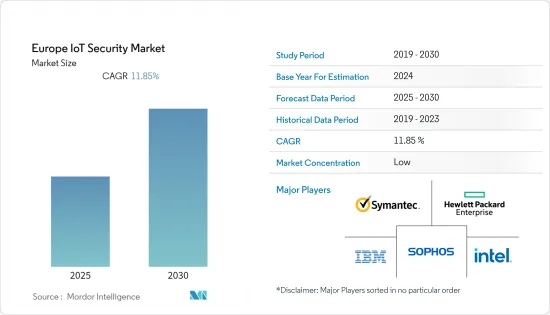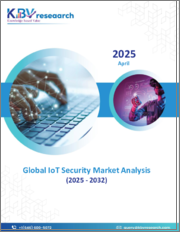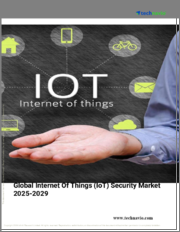
|
시장보고서
상품코드
1640581
유럽의 IoT 보안 시장 전망 : 시장 점유율 분석, 산업 동향 및 통계, 성장 예측(2025-2030년)Europe IoT Security - Market Share Analysis, Industry Trends & Statistics, Growth Forecasts (2025 - 2030) |
||||||
■ 보고서에 따라 최신 정보로 업데이트하여 보내드립니다. 배송일정은 문의해 주시기 바랍니다.
유럽의 IoT 보안 시장은 예측 기간 동안 연평균 성장율(CAGR) 11.85%를 기록할 전망입니다.

주요 하이라이트
- 작년에 유럽 연합 사이버 보안 기관(ENISA)은 하드웨어, 소프트웨어, 서비스 등 전체 사물 인터넷(IoT) 공급망에 대한 보안 지침을 담은 'IoT 보안을 위한 가이드라인 : IoT를 위한 보안 공급망'을 발표했습니다. EU 사이버 보안국은 신뢰할 수 없는 타사 구성 요소 및 공급업체와 타사 구성 요소의 취약성 관리를 IoT 공급망의 두 가지 주요 위협으로 파악하고 다른 노력, 표준 및 가이드라인의 추가 리소스를 제공하는 설문조사를 실시했습니다.
- 또한 5G의 등장은 이미 4차 산업혁명을 추진하고 있는 산업에서 커넥티드 디바이스의 사용을 가속화할 것으로 예상됩니다. IoT와 기계 간 연결의 부상을 통해 산업 전반에 걸쳐 셀룰러 연결을 지원하는 4차 산업혁명도 시장 견인력을 높이는 데 중요한 역할을 하고 있습니다.
- 그 밖에도 여러 혁신 도시 프로젝트와 이니셔티브가 진행 중입니다. 예측 기간까지 전 세계적으로 약 30개의 스마트 시티가 건설될 것으로 예상되며, 이 중 50%가 북미와 유럽에 위치할 것으로 전망됩니다(출처: OECD). OECD에 따르면 이러한 단계는 2010년부터 2030년까지 도시 내 모든 인프라 프로젝트에 약 18,00,000백만 달러에 달하는 글로벌 투자로 뒷받침될 것으로 예상됩니다.
- IoT 보안 솔루션은 개발 시간이 길어지고 복잡성이 증가함에 따라 비용이 증가하기 때문에 비용이 많이 듭니다. 스마트 자동차는 주로 스마트 제조, 커넥티드 홈, 빌딩 자동화 솔루션에 IoT를 사용합니다. 이로 인해 비효율적인 데이터 관리와 상호 운용성 메커니즘이 저하될 수 있습니다. 멀웨어 및 피싱 위협의 위험 증가는 사이버 보안 시장의 성장을 주도하고 있습니다.
- 또한 COVID-19 팬데믹의 영향으로 스마트 홈과 스마트 빌딩을 사이버 보안 위험으로부터 보호하는 것이 중요해지고 있습니다. 사람들은 IoT 기술을 포함한 스마트 카메라, 웨어러블, 통신을 사용하여 집에서 상당한 시간을 보냅니다. 코로나19 팬데믹 기간 동안 커넥티드 디바이스의 사용이 증가하면서 이러한 디바이스는 위협 행위자의 공격에 더 취약해졌고, 이에 따라 이 지역의 IoT 보안에 대한 수요도 증가했습니다.
유럽의 IoT 보안 시장 동향
데이터 유출 건수 증가로 수요 증가 예상
- 기업 전반에서 기술 도입이 증가함에 따라 데이터 유출이 크게 증가했습니다. 사용하기 쉬운 도구에 대한 접근이 용이해지고 갈취를 통한 수익 창출 가능성에 대한 범죄자들의 이해가 넓어지면서 분산 서비스 거부(DDoS) 및 랜섬웨어 공격의 위협이 증가했습니다. 비즈니스 시스템과 개인을 직접 겨냥하는 이러한 공격은 잠재적으로 막대한 금전적, 개인적 손실을 초래할 수 있습니다.
- 가정 및 비즈니스 자동화를 위한 새로운 디바이스가 지속적으로 출시됨에 따라 IoT 봇넷이 생성하는 공격의 속도는 계속 증가할 것으로 보입니다. CSO Online은 의료 산업이 다른 분야보다 더 많은 공격을 받고 있다고 예측하며, IoT 시장의 다양한 최종 사용자 업종에 보안 솔루션 고도화에 대한 경각심을 일깨워주고 있습니다.
- 전기, 수도, 기타 필수 자원과 같이 중요한 인프라는 물론 모든 산업 분야에서 IoT를 도입하고 자동화 단계에 있습니다. 자동화는 운영을 더욱 안정적이고 효율적으로 만들지만, 동시에 사이버 보안 공격에 취약한 시스템을 만들기도 합니다. 이러한 중요 시스템에 대한 공격은 이제 정부와 조직의 주요 관심사입니다.
- 또한 이러한 우려를 해결하기 위해 새로운 규정이 시행되고 공식화되었습니다. 예를 들어, 영국에서는 DCMS에서 매년 사이버 보안 침해 조사에서 가장 흔한 사이버 보안 침해에 관한 공식 통계를 발표하고 있습니다.
- DCMS에 따르면 지난 12개월 동안 사이버 보안 전문가에 대한 수요가 크게 증가했습니다. 작년 한 해 동안 매월 평균 4,400건의 핵심 사이버 보안 관련 채용 공고가 올라와 2020년 대비 58% 증가했습니다. 이는 연간 14,000명의 사이버 보안 전문가가 부족한 것으로 추정됩니다.
영국이 상당한 점유율을 차지할 것으로 예상
- 영국은 유럽 지역에서 기술 도입의 선두에 서 있어 사이버 공격의 위협이 크게 증가하고 있습니다. 글로벌 보험사 Hiscox의 데이터에 따르면 영국의 소기업은 매일 약 65,000건의 사이버 공격을 시도하는 것으로 추정됩니다. 이 보험사에 따르면 작년에 영국 소기업 3곳 중 1곳(30%)이 사이버 침해를 당했으며, 이는 하루에 4,500건 이상, 즉 19초마다 공격이 성공한 것과 같은 수치입니다.
- 영국 정부의 디지털, 문화, 미디어, 스포츠부(DCMS)는 코로나19 팬데믹이 발생한 이후 영국 소비자의 약 49%가 스마트 기기를 하나 이상 구매한 것으로 나타났다는 보고서를 발표했습니다. 작년 11월, 디지털, 문화, 미디어, 스포츠부는 제품 보안 및 통신 인프라(PSTI) 법안을 도입했습니다. 이 법안은 외국산 디바이스의 제조업체, 소매업체, 수입업체를 포함한 전체 IoT 산업에 적용되며, 필요한 보안 표준을 충족하지 못하는 안전하지 않은 IoT 제품이 시장에 출시되지 않도록 보장해야 합니다.
- 지난해 유럽전기통신표준협회(ETSI)는 소비자 사물인터넷 기기를 위한 새로운 사이버 보안 표준(TS 303 645)을 발표했습니다. 이 표준은 인터넷 연결 소비자 제품에 대한 보안 기준을 설정하고, 향후 IoT 인증 제도의 기반을 제공하며, 인터넷 연결 소비자 장치 및 관련 서비스의 보안을 위한 13개 조항을 명시하고 있습니다. 제품 범위에는 연결된 어린이 장난감, 유아용 모니터, 연결된 안전 관련 제품이 포함됩니다.
- 또한 스마트 시티 개념의 중요한 트렌드인 스마트 홈은 여러 가지 이점을 제공합니다. 그러나 계량기, 온도조절기, 엔터테인먼트 장치 등 스마트 홈 환경의 다양한 IoT 기기는 리소스 제약이 있기 때문에 표준화된 보안 솔루션을 구현할 수 없습니다. 따라서 현재 스마트 홈은 보안 위협에 취약한 상태입니다. 이러한 스마트 홈 기술의 개발과 도입은 이 지역의 시장 성장을 촉진할 것으로 예상됩니다.
- 또한 기업은 신기술 개발을 위한 투자를 받고 스마트홈 보안 솔루션 제조에 협력하고 있습니다. Arlo는 지난 5월 영국에서 Arlo Go 2 보안 카메라를 2년간 Arlo secure 구독으로 309.99 파운드로 출시했습니다. 이 카메라는 Wi-Fi 또는 3G 또는 4G SIM 카드에 연결할 수 있습니다. 이 카메라는 100% 무선으로 설치할 수 있으며, 1080p 컬러 HD 비디오의 라이브 스트리밍 기능, Wi-Fi 연결이 끊어진 경우 Wi-Fi에서 셀룰러로 자동 연결 전환 기능 등을 갖추고 있습니다.
유럽의 IoT 보안 산업 개요
유럽의 IoT 보안 시장 경쟁 구도은 신규 시장 진출기업의 출현과 기존 진출기업에 의한 기술 혁신 및 개발 활동에 의해 예측 기간 중에 세분화를 향해 나갈 것으로 예상됩니다. 또한 시장 진출기업은 시장에서의 입지를 확대하기 위해 전략적으로 협력하고 있습니다.
- 2022년 10월 : Telefonica Tech가 BE-terna를 인수하여 확장된 유럽 기술 서비스를 구축했습니다. BE-terna는 클라우드 기반 산업별 솔루션을 제공하는 유럽의 Microsoft 클라우드 솔루션 제공업체입니다. 이 인수를 통해 Telefonica Tech는 유럽에서 입지를 확보함으로써 관련 기술 서비스 업체로 거듭나게 되었습니다.
- 2022년 9월 : 텔레포니카 테크는 IT 및 보안 서비스 시장에서의 입지를 강화하기 위해 인크리멘탈을 인수했습니다. 인크리멘탈은 디지털 혁신 및 데이터 분석 회사입니다. 이번 인수로 Telefonica Tech & Incremental은 영국 시장에서 더 넓은 입지를 확보하고 16개의 골드 역량과 5개의 고급 전문성을 포함하여 더 포괄적인 범위의 Microsoft 기술을 선택할 수 있게 되었습니다.
기타 혜택
- 엑셀 형식 시장 예측(ME) 시트
- 3개월간의 애널리스트 지원
목차
제1장 서론
- 조사의 전제조건과 시장 정의
- 조사 범위
제2장 조사 방법
제3장 주요 요약
제4장 시장 인사이트
- 시장 개요
- 산업의 매력 - Porter's Five Forces 분석
- 공급기업의 협상력
- 소비자의 협상력
- 신규 진입업체의 위협
- 경쟁 기업간 경쟁 관계
- 대체품의 위협
- 산업 밸류체인 분석
- COVID-19의 산업에 대한 영향 평가
제5장 시장 역학
- 시장 성장 촉진요인
- 데이터 유출 증가
- 스마트 시티의 출현
- 시장 성장 억제요인
- 디바이스간의 복잡화와 유비쿼터스 법제의 부족
제6장 시장 세분화
- 보안
- 네트워크 보안
- 엔드포인트 보안
- 용도 보안
- 클라우드 보안
- 기타 보안
- 솔루션
- 소프트웨어
- 서비스
- 최종 사용자 산업
- 자동차
- 의료
- 정부기관
- 제조업
- 에너지 전력
- 소매업
- 국가명
- 영국
- 독일
- 프랑스
- 이탈리아
- 기타 유럽
제7장 경쟁 구도
- 기업 프로파일
- Symantec Corporation
- IBM Corporation
- Sophos Group PLC
- Intel Corporation
- Hewlett Packard Enterprise Company
- FORTINET INC
- Infineon Technologies AG
- Palo Alto Networks Inc
- Gemalto NV(Thales Group)
- SecureIoT
제8장 투자 분석
제9장 시장의 미래
HBR 25.02.13The Europe IoT Security Market is expected to register a CAGR of 11.85% during the forecast period.

Key Highlights
- In the previous year, European Union Agency for Cybersecurity (ENISA) released its Guidelines for Securing the IoT - Secure Supply Chain for IoT, which covers the entire Internet of Things (IoT) supply chain - hardware, software, and services. EU Agency for Cybersecurity conducted a survey that identifies untrusted third-party components and vendors and the vulnerability management of third-party components as the two main threats to the IoT supply chain and offers additional resources from other initiatives, standards, and guidelines.
- Further, the emergence of 5G is expected to expedite the use of connected devices in the industries already pushing toward the industrial revolution 4.0. Industrial revolution 4.0, aiding cellular connectivity throughout the sector through the rise of IoT and machine-to-machine connections, has also been instrumental in driving market traction.
- Several other innovative city projects and initiatives are ongoing. By the forecasted period, it is expected that there will be around 30 global smart cities, and 50% of these will be located in North America and Europe (source: OECD). According to the OECD, these steps are supported by global investments, which would be about USD 18,00,000 million between 2010 and 2030 for all infrastructure projects in urban cities.
- IoT security solutions are costly, as security adds expense due to longer development times and increased complexity. Smart cars primarily use IoT for smart manufacturing, connected homes, and building automation solutions. This can lead to inefficient data management and a reduced interoperability mechanism. The increase in the risk of malware and phishing threats drives the growth of the cyber security market.
- Moreover, the Covid-19 pandemic impacts resulted in securing smart homes and smart buildings from cybersecurity risks has become more relevant. People spend considerable time at home using smart cameras, wearables, and telecommunications, including IoT technology. With the increasing usage of connected devices during the Covid-19 pandemic, these devices have become more susceptible to attacks from threat actors, thereby increasing the demand for IoT security in the region.
Europe IoT Security Market Trends
Increasing Number of Data Breaches is Expected to Boost the Demand
- Data breaches have increased substantially with the increase in technology adoption across enterprises. The threat of distributed denial of service (DDoS) and ransomware attacks has increased because of the ready access to easy-to-use tools and a broader criminal understanding of its potential for profit through extortion. These attacks, which directly target business systems and individuals, may potentially lead to enormous financial and personal losses.
- With new devices being rolled out constantly for both home and business automation, the pace of attacks generated by IoT botnets is likely to continue to increase. CSO Online prediction puts that the healthcare industry is being attacked more than most other sectors, thus, alerting the various end-user verticals of the IoT market to advance their security solutions.
- Infrastructures that are critical such as electricity, water, and other essential resources, as well as all the industry verticals, are adopting IoT and are in the phase of automation. Automation makes operations more reliable and efficient but also makes systems prone to attacks on cybersecurity. The attacks on these critical systems are now a primary concern for governments and organizations.
- Further, to address the concern, new regulations came into effect and have been formulated. For instance, in the United Kingdom, the official statistics regarding the most common cybersecurity breaches are published annually by DCMS in the cybersecurity Breaches Survey.
- According to DCMS, over the past 12 months, the demand for cybersecurity professionals has increased significantly. On average, there were 4,400 core cyber security postings each month of the last year, which resulted in an increase of 58% from 2020. This depicts an estimated annual shortfall of a14,000 cyber security professionals.
United Kingdom Expected to Hold a Considerable Share
- The United Kingdom has been at the forefront of technology adoption in the European region, substantially increasing the threat of cyber attacks. According to data from the global insurer Hiscox, small businesses in the United Kingdom target an estimated 65,000 attempted cyber attacks every day. According to the insurer, almost one in three (30%) UK small businesses suffered a cyber breach last year - equivalent to over 4,500 successful attacks per day or every 19 seconds.
- The department for Digital, Culture, Media, and Sport (DCMS) of the United Kingdom government has published reports showing that almost 49% of consumers in the United Kingdom have bought at least one smart device since the outbreak of the Covid-19 pandemic. In November last year, the Department for Digital, Culture, Media, and Sport introduced the Product Security and Telecommunications Infrastructure (PSTI) Bill. The Bill applies to the whole IoT industry, including manufacturers, retailers, and importers of foreign-manufactured devices, who must ensure that no unsafe IoT products go to market if they do not meet the required security standards.
- In the previous year, the European Telecommunications Standards Institute (ETSI) released a new cybersecurity standard for consumer Internet of Things devices (TS 303 645). The measure establishes a security baseline for internet-connected consumer products, provides a basis for future IoT certification schemes, and specifies 13 provisions for the security of internet-connected consumer devices and their associated services. The scope of the products includes connected children's toys, baby monitors, and connected safety-relevant products.
- Also, the Smart home, a significant trend in the smart city concept, offers several benefits. However, the resource-constrained nature of various IoT devices in a smart home environment, such as meters, thermostats, and entertainment units, does not permit the implementation of standardized security solutions. Therefore, currently, smart homes are vulnerable to security threats. Such developments and adopting of smart home technology are also expected to boost the market growth in the region.
- Moreover, companies are gaining investments to develop new technologies and collaborate in producing smart home security solutions. In May last year, Arlo launched Arlo Go 2 security camera in the United Kingdom for GBP 309.99, including a 2-year Arlo secure subscription. This camera can be connected to Wi-Fi or through a 3G or 4G SIM card. It provides a 100% wireless installation and offers 1080p color HD video live streaming capabilities, automatic connectivity switching from Wi-Fi to cellular in case of Wi-Fi drop, and many more.
Europe IoT Security Industry Overview
The competitive landscape of the European IoT Security Market is expected to move towards fragmentation over the forecast period due to the emergence of new market players and innovation and development activities by the existing players. The market players are also strategically collaborating to expand their market presence.
- October 2022 - Telefonica Tech acquired BE-terna, building a scaled European Tech Services. BE-terna is a European Microsoft Cloud solutions provider with cloud-based industry-specific solutions. The acquisition results in Telefonica Tech as a relevant Tech services player by securing a European presence.
- September 2022 - Telefonica Tech acquired Incremental to strengthen its position in the market for IT and security services. Incremental is a digital transformation and data analytics company. With this acquisition, Telefonica Tech & Incremental has a broader footprint in the United Kingdom market and a more comprehensive range of Microsoft technologies to choose from, including 16 Gold Competencies and 5 Advanced Specializations.
Additional Benefits:
- The market estimate (ME) sheet in Excel format
- 3 months of analyst support
TABLE OF CONTENTS
1 INTRODUCTION
- 1.1 Study Assumptions and Market Definition
- 1.2 Scope of the Study
2 RESEARCH METHODOLOGY
3 EXECUTIVE SUMMARY
4 MARKET INSIGHT
- 4.1 Market Overview
- 4.2 Industry Attractiveness - Porter's Five Forces Analysis
- 4.2.1 Bargaining Power of Suppliers
- 4.2.2 Bargaining Power of Consumers
- 4.2.3 Threat of New Entrants
- 4.2.4 Intensity of Competitive Rivalry
- 4.2.5 Threat of Substitutes
- 4.3 Industry Value Chain Analysis
- 4.4 Assessment of Impact of COVID-19 on the Industry
5 MARKET DYNAMICS
- 5.1 Market Drivers
- 5.1.1 Increasing Number of Data Breaches
- 5.1.2 Emergence of Smart Cities
- 5.2 Market Restraints
- 5.2.1 Growing Complexity among Devices, Coupled with the Lack of Ubiquitous Legislation
6 MARKET SEGMENTATION
- 6.1 Security
- 6.1.1 Network Security
- 6.1.2 End-point Security
- 6.1.3 Application Security
- 6.1.4 Cloud Security
- 6.1.5 Other Securities
- 6.2 Solution
- 6.2.1 Software
- 6.2.2 Services
- 6.3 End-user Industry
- 6.3.1 Automotive
- 6.3.2 Healthcare
- 6.3.3 Government
- 6.3.4 Manufacturing
- 6.3.5 Energy and Power
- 6.3.6 Retail
- 6.4 Country
- 6.4.1 United Kingdom
- 6.4.2 Germany
- 6.4.3 France
- 6.4.4 Italy
- 6.4.5 Rest of Europe
7 COMPETITIVE LANDSCAPE
- 7.1 Company Profiles
- 7.1.1 Symantec Corporation
- 7.1.2 IBM Corporation
- 7.1.3 Sophos Group PLC
- 7.1.4 Intel Corporation
- 7.1.5 Hewlett Packard Enterprise Company
- 7.1.6 FORTINET INC
- 7.1.7 Infineon Technologies AG
- 7.1.8 Palo Alto Networks Inc
- 7.1.9 Gemalto NV (Thales Group)
- 7.1.10 SecureIoT
8 INVESTMENT ANALYSIS
9 FUTURE OF THE MARKET
샘플 요청 목록



















